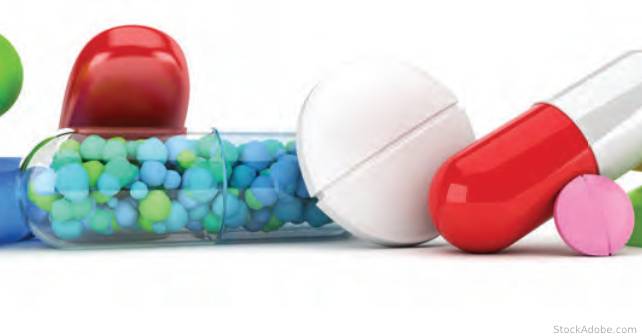
Many common presentations to the emergency department (ED) are related to drug interactions that are commonly missed and largely preventable.1-3 We may be unaware of potentially dangerous drug interactions when we order and prescribe medications in the ED. The resulting morbidity and mortality is significant.4-6 Delirium, syncope, and falls are three presentations that should trigger a careful medication history and search for potential drug interactions.7 Clinical criteria validated to identify patients at especially high risk for drug interactions, in whom a medication review should be done, include: having a preexisting medical condition; having taken antibiotics in the last week; age older than 80 years; and having a medication change in the past month.8 It is just only older patients who are at risk for drug interactions. Patients with psychiatric illness and renal disease should give us pause not only for unexplained presentations but also when ordering and prescribing medications for these patients in the ED.9,10 This column reviews key drug interactions in older patients, those with psychiatric illness and those with renal disease, as well as three essential categories of drugs where careful ED ordering and prescribing should be considered.
Explore This Issue
ACEP Now: Vol 43 – No 01 – January 2024Three Groups of Patients at High Risk for Drug Interactions
Older patients are especially sensitive to medications with a narrow therapeutic range such as diabetes medications (insulin, sulfonylureas), anticoagulants, sedatives, immunosuppressants, and anticonvulsants.11 Whenever ordering or prescribing analgesics for an older patient careful consideration must be given to NSAIDs that can cause or exacerbate peptic ulcer disease and alter glycemic control in people with diabetes.12,13 Older patients are sensitive to the sedative effects of opioids, especially in combination with benzodiazepines, and avoidance of combinations or dosing adjustments should be made accordingly, to prevent mortality from this drug interaction in particular.14
In patients with psychiatric illness, three consequences of drug interactions should always be considered with unexplained ED presentations or when ordering or prescribing medications: serotonin syndrome, neuroleptic malignant syndrome (NMS) and QT prolongation. Most antidepressants act on the serotonin system, and in combination, at high doses, and/or with other medications (antipsychotics, lithium, fentanyl, cocaine, methadone, or metoclopramide) may put patients at risk for life-threatening serotonin syndrome.15 We should be aware that fentanyl administration during procedural sedation in patients taking serotonin reuptake inhibitors may result in serotonin syndrome, which therefore should be on our differential diagnosis in patients who emerge from sedation with agitation.16 Antipsychotics in combination, at regular or at high doses, can increase the risk of NMS causing autonomic instability.17 QT prolongation depends on the number of potentially QT-prolonging drugs, the class of drugs, and the specific medication.18 Especially high-risk drugs include citalopram or escitalopram in combination with erythromycin, moxifloxacin or ondansetron.19
Renal patients are at high risk for drug interactions owing to impaired clearance of some drugs and their tendency to be on multiple medication for their comorbidities. There are two specific drug-related scenarios in the patient with renal disease for emergency physicians to be aware of: hyperkalemia, and dose adjustments for drugs that are renally excreted. Many drugs can pre-dispose to hyperkalemia, including angiotensin-converting-enzyme inhibitors, angiotensin receptor blockers, spironolactone, trimethoprim-sulfamethoxazole, heparin, and NSAIDs. The risk of hyperkalemia increases when these medications are combined in renal patients who have a decreased ability to eliminate potassium. A particularly concerning drug interaction is trimethoprim-sulfamethoxazole in combination with spironolactone, which clearly increases the risk for hyperkalemia and sudden cardiac death.20 When it comes to impaired drug elimination direct oral anticoagulants, colchicine, and digoxin are particularly important and require dose or interval adjustment in renal patients.21
Three Categories of Drugs Are Commonly Involved in Drug Interactions
Three categories of drugs prescribed commonly in EDs carry significant potentially dangerous drug interactions: antimicrobials, analgesics, and cardiovascular drugs. Aside from the trimethoprim-spironolactone interaction mentioned above, trimethoprim-sulfamethoxazole also interacts with warfarin to cause supratherapeutic international normalized ratio values and increased bleeding risk, and with angiotensin-converting-enzyme inhibitors or angiotensin receptor blockers to cause hyperkalemia.22,23 Macrolides are another group of antibiotics to be careful prescribing. Clarithromycin or erythromycin when combined with lipophilic statins such as atorvastatin, lovastatin, or simvastatin, increases the concentration of the statin, thus increasing the risk for rhabdomyolysis.24 Erythromycin or clarithromycin in combination with amlodipine can lead to clinically significant hypotension.25 When choosing a macrolide, azithromycin is generally considered the safest with regard to drug interactions.
Analgesics are another important category of drugs when it comes to drug interactions. Opioids in combination with any sedating medication should be avoided whenever possible. A less well recognized drug interaction in this category includes nonsteroidal antiinflammatory drugs in combination with acetylsalicylic acid, leading to a higher risk of arterial thrombosis.26
The third category of drugs that are often involved in drug interactions are cardiovascular drugs. Important underrecognized interactions for emergency physicians include: warfarin plus acetaminophen increasing international normalized ratio and bleeding, beta-blockers plus cholinesterase inhibitors causing bradycardia and syncope, and insulin plus beta-blockers leading to hypoglycemia.27-29
Next time you are faced with a patient presenting with syncope or altered level of awareness, or you are considering prescribing antibiotics, analgesics, or cardiovascular drugs in the ED, consider these potentially life-threatening drug interactions–you may pick up an iatrogenic cause or narrowly avert an iatrogenic disaster!
Many thanks to Dr. David Juurlink and Dr. Walter Himmel for their expert contributions to the EM Cases podcast that inspired this article.
 Dr. Helman is an emergency physician at North York General Hospital in Toronto. He is an assistant professor at the University of Toronto, Division of Emergency Medicine, and the education innovation lead at the Schwartz/Reisman Emergency Medicine Institute. He is the founder and host of Emergency Medicine Cases podcast and website.
Dr. Helman is an emergency physician at North York General Hospital in Toronto. He is an assistant professor at the University of Toronto, Division of Emergency Medicine, and the education innovation lead at the Schwartz/Reisman Emergency Medicine Institute. He is the founder and host of Emergency Medicine Cases podcast and website.
References
- Hohl CM, Robitaille C, Lord V, et al. Emergency physician recognition of adverse drug-related events in elder patients presenting to an emergency department. Acad Emerg Med. 2005;12:197-205.
- Hohl CM, Zed PJ, Brubacher JR, et al. Do emergency physicians attribute drug-related emergency department visits to medication-related problems? Ann Emerg Med. 2010;55:493-502.
- Classen D, Pestotnik S, Evans S, et al. Adverse drug events in hospitalized patients. JAMA. 1997;277:301-6.
- Zed PJ, Abu-Laban RB, Balen RM, et al. Incidence, severity and preventability of medication-related visits to the emergency department: a prospective study. CMAJ. 2008;178:1563-9.
- Rosas-Carrasco O, García-Peña C, Sánchez-García S, et al. The relationship between potential drug-drug interactions and mortality rate of elderly hospitalized patients. Rev Invest Clin. 2011;63(6):564-73.
- Chang TI, Park H, Kim DW, et al. Polypharmacy, hospitalization, and mortality risk: a nationwide cohort study. Sci Rep. 2020;10(1):18964.
- Pretorius RW, Gataric G, Swedlund SK, et al. Reducing the risk of adverse drug events in older adults. Am Fam Physician. 2013;87(5):331-6.
- Hohl CM, Badke K, Zhao A, et al. Prospective validation of clinical criteria to identify emergency department patients at high risk for adverse drug events. Acad Emerg Med. 2018;25(9):1015-26.
- Wolff J, Hefner G, Normann C, et al. Predicting the risk of drug-drug interactions in psychiatric hospitals: a retrospective longitudinal pharmaco-vigilance study. BMJ Open. 2021;11(4):e045276.
- Mendu ML, Waikar SS. Drug-drug interactions and acute kidney injury: caveat prescriptor. Am J Kidney Dis. 2014;64(4):492-4.
- Parker BM, Cusack BJ, Vestal RE. Pharmacokinetic optimisation of drug therapy in elderly patients. Drugs Aging. 1995;7(1):10-8.
- Visser LE, Graatsma HH, Stricker BH. Contraindicated NSAIDs are frequently prescribed to elderly patients with peptic ulcer disease. Br J Clin Pharmacol. 2002;53(2):183-8.
- Wongrakpanich S, Wongrakpanich A, Melhado K, et al. A comprehensive review of non-steroidal anti-inflammatory drug use in the elderly. Aging Dis. 2018;9(1):143-150.
- Boon M, van Dorp E, Broens S, et al. Combining opioids and benzodiazepines: effects on mortality and severe adverse respiratory events. Ann Palliat Med. 2020;9(2):542-557.
- Talton CW. Serotonin syndrome/serotonin toxicity. Fed Pract. 2020;37(10):452-459.
- Kirschner R, Donovan JW. Serotonin syndrome precipitated by fentanyl during procedural sedation. J Emerg Med. 2010;38(4):477-80.
- Kyotani Y, Zhao J, Nakahira K, et al. The role of antipsychotics and other drugs on the development and progression of neuroleptic malignant syndrome. Sci Rep. 2023;13(1):18459.
- Meid AD, Bighelli I, Mächler S, et al. Combinations of QTc-prolonging drugs: towards disentangling pharmacokinetic and pharmacodynamic effects in their potentially additive nature. Ther Adv Psychopharmacol. 2017;7(12):251-264
- Nachimuthu S, Assar MD, Schussler JM. Druginduced QT interval prolongation: mechanisms and clinical management. Ther Adv Drug Saf. 2012;3(5):241-53.
- Antoniou T, Hollands S, Macdonald EM, et al. Trimethoprim-sulfamethoxazole and risk of sudden death among patients taking spironolactone. CMAJ. 2015;187(4):E138-E143.
- Lea-Henry TN, Carland JE, Stocker SL, et al. Clinical pharmacokinetics in kidney disease: Fundamental principles. Clin J Am Soc Nephrol. 2018;13(7):1085-95.
- Clark NP, Delate T, Riggs CS, et al. Warfarin interactions with antibiotics in the ambulatory care setting. JAMA Intern Med. 2014;174(3):409-16.
- Antoniou T, Gomes T, Juurlink DN, et al. Trimethoprim-sulfamethoxazole-induced hyperkalemia in patients receiving inhibitors of the renin-angiotensin system: a population-based study. Arch Intern Med. 2010;170(12):1045-9.
- Abu Mellal A, Hussain N, Said AS. The clinical significance of statins-macrolides interaction: comprehensive review of in vivo studies, case reports, and population studies. Ther Clin Risk Manag. 2019;15:921-36.
- Wright AJ, Gomes T, Mamdani MM, et al. The risk of hypotension following co-prescription of macrolide antibiotics and calcium-channel blockers. CMAJ. 2011;183(3):303-7.
- Schjerning Olsen AM, Gislason GH, McGettigan P, et al. Association of NSAID use with risk of bleeding and cardiovascular events in patients receiving antithrombotic therapy after myocardial infarction. JAMA. 2015;313(8):805-14.
- Dharmarajan L, Sajjad W. Potentially lethal acetaminophen-warfarin interaction in an older adult: an under-recognized phenomenon? J Am Med Dir Assoc. 2007;8(8):545-7.
- Paulison B, Léos CL. Potential cardiotoxic reaction involving rivastigmine and beta-blockers: a case report and review of the literature. Cardiovasc Toxicol. 2010;10(4):306-10.
- Mills GA, Horn JR. Beta-blockers and glucose control. Drug Intell Clin Pharm. 1985;19(4):246-51.
Pages: 1 2 3 4 | Multi-Page





No Responses to “These Patients and Drugs are Commonly Involved in Drug Interactions”